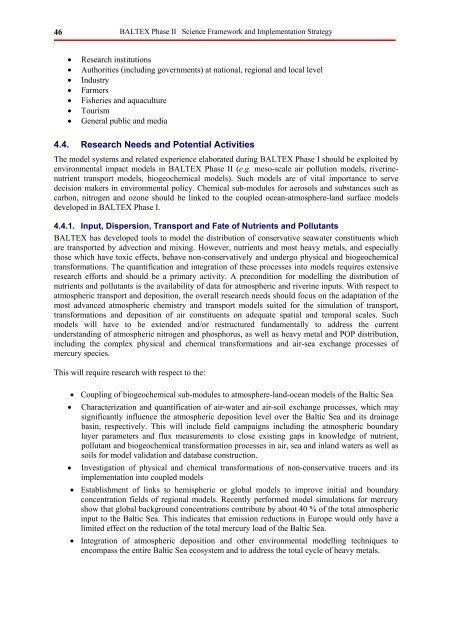BALTEX Phase II 2003 â 2012. Science Framework and ...
BALTEX Phase II 2003 â 2012. Science Framework and ...
BALTEX Phase II 2003 â 2012. Science Framework and ...
You also want an ePaper? Increase the reach of your titles
YUMPU automatically turns print PDFs into web optimized ePapers that Google loves.
46<br />
<strong>BALTEX</strong> <strong>Phase</strong> <strong>II</strong> <strong>Science</strong> <strong>Framework</strong> <strong>and</strong> Implementation Strategy<br />
• Research institutions<br />
• Authorities (including governments) at national, regional <strong>and</strong> local level<br />
• Industry<br />
• Farmers<br />
• Fisheries <strong>and</strong> aquaculture<br />
• Tourism<br />
• General public <strong>and</strong> media<br />
4.4. Research Needs <strong>and</strong> Potential Activities<br />
The model systems <strong>and</strong> related experience elaborated during <strong>BALTEX</strong> <strong>Phase</strong> I should be exploited by<br />
environmental impact models in <strong>BALTEX</strong> <strong>Phase</strong> <strong>II</strong> (e.g. meso-scale air pollution models, riverinenutrient<br />
transport models, biogeochemical models). Such models are of vital importance to serve<br />
decision makers in environmental policy. Chemical sub-modules for aerosols <strong>and</strong> substances such as<br />
carbon, nitrogen <strong>and</strong> ozone should be linked to the coupled ocean-atmosphere-l<strong>and</strong> surface models<br />
developed in <strong>BALTEX</strong> <strong>Phase</strong> I.<br />
4.4.1. Input, Dispersion, Transport <strong>and</strong> Fate of Nutrients <strong>and</strong> Pollutants<br />
<strong>BALTEX</strong> has developed tools to model the distribution of conservative seawater constituents which<br />
are transported by advection <strong>and</strong> mixing. However, nutrients <strong>and</strong> most heavy metals, <strong>and</strong> especially<br />
those which have toxic effects, behave non-conservatively <strong>and</strong> undergo physical <strong>and</strong> biogeochemical<br />
transformations. The quantification <strong>and</strong> integration of these processes into models requires extensive<br />
research efforts <strong>and</strong> should be a primary activity. A precondition for modelling the distribution of<br />
nutrients <strong>and</strong> pollutants is the availability of data for atmospheric <strong>and</strong> riverine inputs. With respect to<br />
atmospheric transport <strong>and</strong> deposition, the overall research needs should focus on the adaptation of the<br />
most advanced atmospheric chemistry <strong>and</strong> transport models suited for the simulation of transport,<br />
transformations <strong>and</strong> deposition of air constituents on adequate spatial <strong>and</strong> temporal scales. Such<br />
models will have to be extended <strong>and</strong>/or restructured fundamentally to address the current<br />
underst<strong>and</strong>ing of atmospheric nitrogen <strong>and</strong> phosphorus, as well as heavy metal <strong>and</strong> POP distribution,<br />
including the complex physical <strong>and</strong> chemical transformations <strong>and</strong> air-sea exchange processes of<br />
mercury species.<br />
This will require research with respect to the:<br />
• Coupling of biogeochemical sub-modules to atmosphere-l<strong>and</strong>-ocean models of the Baltic Sea<br />
• Characterization <strong>and</strong> quantification of air-water <strong>and</strong> air-soil exchange processes, which may<br />
significantly influence the atmospheric deposition level over the Baltic Sea <strong>and</strong> its drainage<br />
basin, respectively. This will include field campaigns including the atmospheric boundary<br />
layer parameters <strong>and</strong> flux measurements to close existing gaps in knowledge of nutrient,<br />
pollutant <strong>and</strong> biogeochemical transformation processes in air, sea <strong>and</strong> inl<strong>and</strong> waters as well as<br />
soils for model validation <strong>and</strong> database construction.<br />
• Investigation of physical <strong>and</strong> chemical transformations of non-conservative tracers <strong>and</strong> its<br />
implementation into coupled models<br />
• Establishment of links to hemispheric or global models to improve initial <strong>and</strong> boundary<br />
concentration fields of regional models. Recently performed model simulations for mercury<br />
show that global background concentrations contribute by about 40 % of the total atmospheric<br />
input to the Baltic Sea. This indicates that emission reductions in Europe would only have a<br />
limited effect on the reduction of the total mercury load of the Baltic Sea.<br />
• Integration of atmospheric deposition <strong>and</strong> other environmental modelling techniques to<br />
encompass the entire Baltic Sea ecosystem <strong>and</strong> to address the total cycle of heavy metals.













